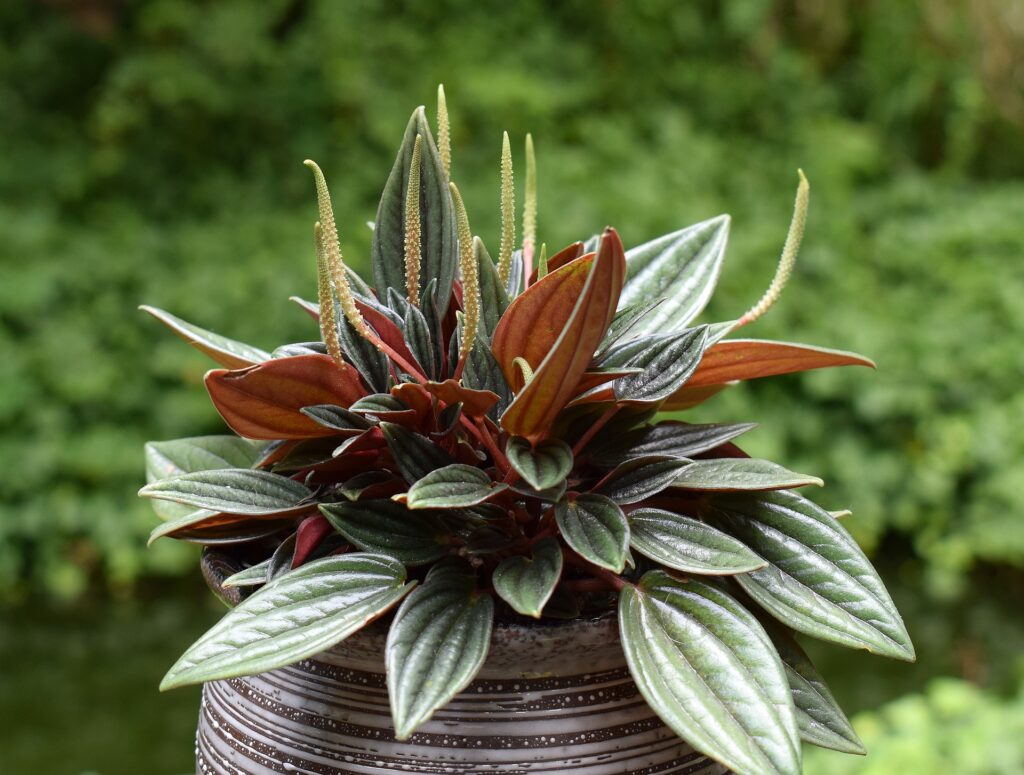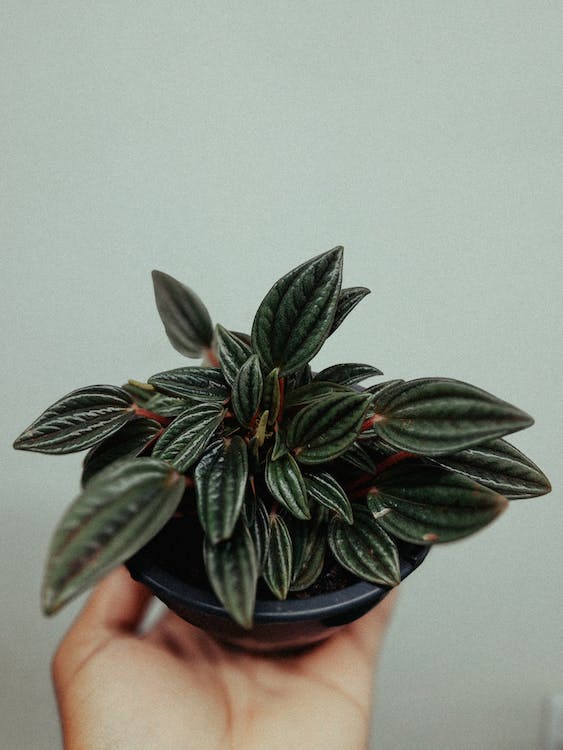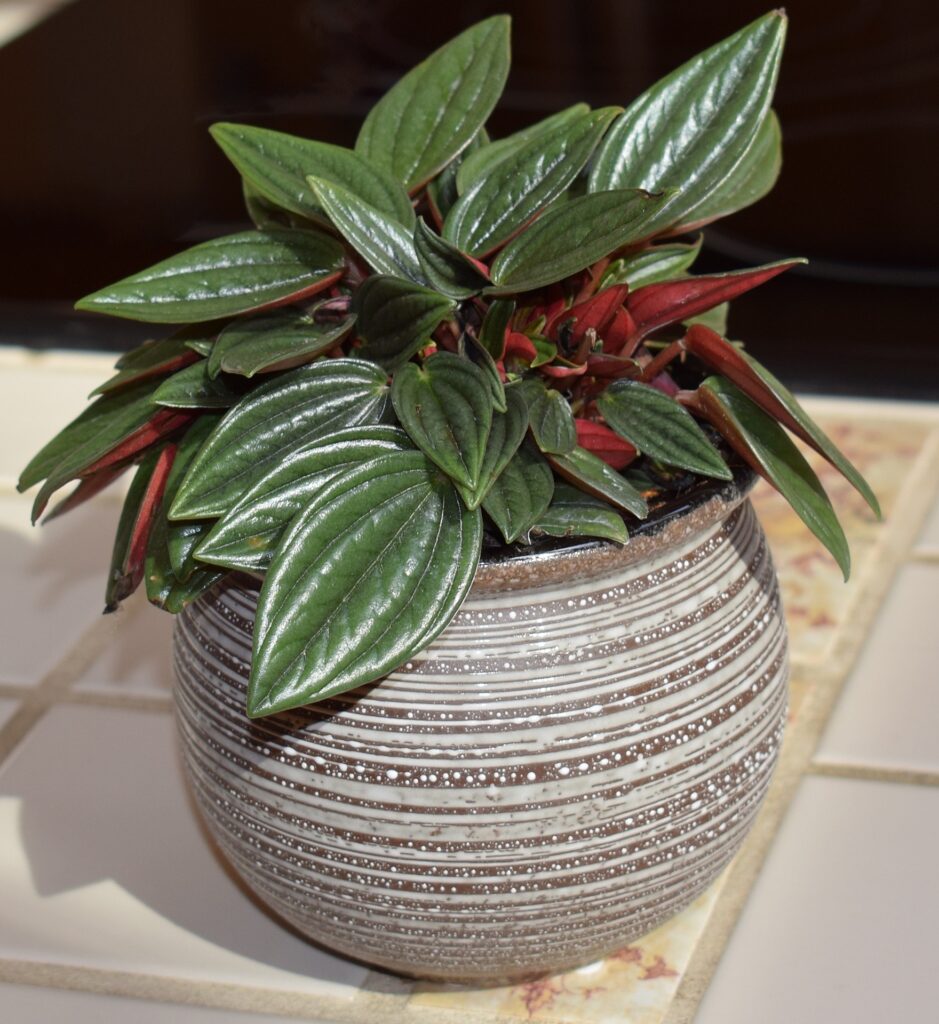Peperomia Rosso, with its attractive and vibrant leaves, has become a popular choice among houseplant enthusiasts. Its beautiful leaves and ease of care make it a perfect addition to any indoor garden.
Peperomia Rosso, scientifically known as Peperomia Caperata, is a tropical perennial plant native to South America.
It belongs to the Piperaceae family and is characterized by deeply grooved heart-shaped leaves. The leaves come in a variety of colors, including shades of green, red, and silver, making it an attractive houseplant.
There are several popular varieties of Peperomia Rosso, each with its unique leaf patterns and colors. Some well-known varieties include:
- Peperomia Rosso ‘Red Ripple’ – featuring deeply textured leaves with reddish undersides.
- Peperomia Rosso ‘Silver Frost’ – known for its silver and green variegated leaves.
- Peperomia Rosso ‘Emerald Ripple’ – displaying glossy green leaves with striking red undersides.
| Characteristic | Description |
|---|---|
| Scientific Name | Peperomia caperata ‘Rosso’ |
| Common Name | Peperomia Rosso |
| Family | Piperaceae (Pepper family) |
| Type | Evergreen, perennial succulent |
| Foliage | Heart-shaped leaves with prominent veins, dark green on the upper surface and red or burgundy underneath |
| Leaf Color | Dark green with a reddish or burgundy underside |
| Flowers | Insignificant greenish-white flower spikes |
| Light Requirements | Medium to bright, indirect light |
| Watering | Allow the top inch of soil to dry before watering; avoid overwatering |
| Soil | Well-draining potting mix, peat-based |
| Humidity | Prefers higher humidity but can adapt to average levels |
| Temperature | Average to warm temperatures, protect from cold drafts |
| Propagation | Leaf cuttings or stem cuttings |
| Common Uses | Indoor ornamental plant, suitable for containers and terrariums |
| Special Features | Unique foliage with a contrasting color scheme, suitable for low-maintenance indoor environments |
Peperomia Rosso Care Growing Conditions
Light
Peperomia Rosso prefers bright, indirect light. Placing it near a north-facing window or a few feet away from an east or west-facing window will offer the ideal light conditions. Direct sunlight should be avoided as it can scorch the delicate leaves.
Temperature
Maintain a consistent temperature between 65°F to 75°F (18°C to 24°C) during the day and slightly cooler at night. Avoid exposing the plant to drastic temperature fluctuations, as it can lead to stress and affect growth.
Humidity
Peperomia Rosso enjoys moderate humidity levels. If you live in a dry climate, consider using a humidifier or placing a shallow tray filled with water and pebbles near the plant to increase humidity.
Soil
Use a well-draining, aerated soil mix for your Peperomia Rosso. A mixture of peat moss, perlite, and orchid bark works well to provide the necessary drainage and aeration for healthy root growth.
Watering
Proper watering is crucial for the well-being of your Peperomia Rosso. Here are some tips to help you strike the right balance:
- Water the plant when the top inch of the soil feels dry to the touch. Overwatering can lead to root rot, while underwatering can cause the leaves to wilt.
- Ensure that excess water can drain freely from the pot to prevent waterlogging.
- During the winter months, reduce the watering frequency as the plant’s growth slows down.
Size
Peperomia Rosso (Peperomia Caperata ‘Rosso’) is a small to medium-sized houseplant with compact and bushy growth. The leaves form rosettes and are relatively small, measuring about 2 to 4 inches (5 to 10 centimeters) in length.
Mature plants can reach a height of around 6 to 12 inches (15 to 30 centimeters). Its compact size makes Peperomia Rosso suitable for small spaces, tabletops, and shelves, while its attractive foliage adds beauty to indoor spaces. The plant is non-toxic, making it safe for households with pets and children.

Peperomia Rosso Care and Maintenance
Caring for Peperomia Rosso is relatively straightforward, but it does require some attention.
Pruning and Trimming
Regularly prune any dead or yellowing leaves to maintain the plant’s health and appearance. Trim leggy stems to encourage bushier growth.
Fertilizing Peperomia Rosso
Fertilize the plant once every two to four weeks during the growing season (spring and summer) using a balanced liquid fertilizer. Avoid over-fertilization, as it can harm the plant.
Pest Control
Peperomia Rosso is generally pest-resistant, but it can occasionally be affected by mealybugs or spider mites. Inspect your plant regularly and treat any infestations promptly.
Propagation Methods
Peperomia Rosso can be propagated through stem cuttings or leaf cuttings. Ensure the cuttings have a node and place them in a well-draining rooting medium until they develop roots.
Display and Decor Tips
Peperomia Rosso’s attractive foliage makes it an excellent choice for enhancing the aesthetics of your living space. Consider the following display and decor tips:
- Showcase your Peperomia Rosso on a windowsill or a well-lit shelf to highlight its vibrant leaves.
- Pair it with other houseplants to create a lush and visually appealing indoor garden.
- Choose decorative pots that complement the plant’s colors and patterns.
Types of Peperomia Rosso
- Peperomia caperata ‘Rosso’:
- Characteristics: This cultivar is known for its deeply rippled, heart-shaped leaves with a reddish coloration. It’s often chosen for its unique foliage.
- Peperomia graveolens ‘Ruby Glow’:
- Characteristics: This Peperomia has dark red or burgundy leaves that resemble the color of rubies. The leaves are succulent and have a unique glossy appearance.
- Peperomia clusiifolia ‘Jelly’:
- Characteristics: The ‘Jelly’ cultivar features waxy, elliptical leaves with a dark green and red coloration. The combination of colors gives it an attractive appearance.
Common Issues and Troubleshooting
Even with proper care, Peperomia Rosso may encounter some common issues.
Overwatering and Underwatering
Overwatering can lead to root rot, while underwatering can cause wilting and dryness. Strike a balance by monitoring the soil’s moisture levels and adjusting your watering accordingly.
Yellow Leaves and Brown Tips
Yellow leaves may indicate overwatering or nutrient deficiencies, while brown tips could be a sign of underwatering or low humidity. Identify the cause and adjust your care routine accordingly.
Benefits of Having Peperomia Rosso
Apart from being visually pleasing, having Peperomia Rosso in your home offers several benefits:
- Air Purification: Peperomia Rosso can help improve indoor air quality by filtering out harmful pollutants.
- Stress Reduction: Caring for plants like Peperomia Rosso can have a calming effect and reduce stress levels.
- Easy Care: It’s a low-maintenance plant, making it an ideal choice for beginners and busy individuals.

Toxicity of Peperomia Rosso
Peperomia Rosso (Peperomia Caperata ‘Rosso’) is a non-toxic houseplant, making it safe for both humans and pets.
Although it is generally harmless if ingested in small amounts, it is best to keep all plants out of reach of pets and children to prevent any potential problems.
If large amounts are consumed and any symptoms of illness are observed, it is recommended to seek medical help. Overall, Peperomia rosso is a safe and attractive option for indoor plant Enthusiasts.
Peperomia Rosso Fragrance
Peperomia Rosso, also known as Red Ripple Peperomia, is a popular houseplant appreciated for its attractive foliage, with green leaves and red undersides.
However, it doesn’t typically have a strong fragrance. Its main appeal lies in the unique leaf shapes and colors, making it a great choice for indoor decoration.
If you seek fragrant plants, consider other options like Lavender, Jasmine, Gardenia, or Citrus varieties.
Conclusion
Peperomia Rosso is a captivating and low-maintenance houseplant that can add a touch of elegance to any indoor space.
By following the tips and techniques outlined in this comprehensive guide, you can ensure that your Peperomia Rosso thrives and becomes the centerpiece of your green haven.
| Bloom Months Peperomia Rosso generally blooms in the spring and summer months. Use a balanced fertilizer during the growing season, prune to encourage growth, and be patient as flowering can take time and not all plants may bloom. |
FAQs
- Q: Is Peperomia Rosso safe for pets? A: Yes, Peperomia Rosso is non-toxic to cats and dogs, making it a pet-friendly houseplant.
- Q: How often should I fertilize my Peperomia Rosso? A: Fertilize your Peperomia Rosso every two to four weeks during the growing season (spring and summer).
- Q: Can I propagate my Peperomia Rosso in water? A: While it’s possible to propagate Peperomia Rosso in water, it’s generally more successful using a well-draining rooting medium.
- Q: Why are the leaves of my Peperomia Rosso turning yellow? A: Yellow leaves may indicate overwatering, nutrient deficiencies, or inadequate light. Assess the care conditions and make adjustments accordingly.
- Q: How big does Peperomia Rosso typically grow? A: Peperomia Rosso usually grows to a height of 6 to 8 inches (15 to 20 cm) and has a compact, bushy growth habit.

